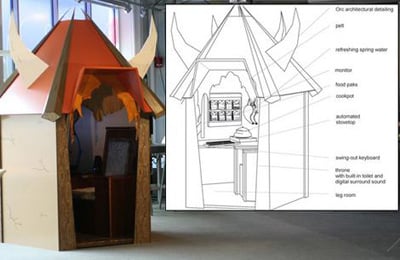Latest Gear Live Videos
IBM disables Siri on employee iPhones in the name of security

Posted by Andru Edwards Categories: Apple, Smartphones, Corporate News, Software,

In an interview with MIT publication Technology Review, IBM CIO Jeanette Horan admitted that the company disables the use of Siri on employee iPhone smartphones. Why is that? Well, since anything spoken to Siri is sent and stored on Apple servers, the thinking is that employees may speak things that shouldn't be in the hands of anyone but IBM--and certainly not in the hands of one of its toughest competitors.
It's not just Siri that's not allowed. Cloud sharing tools like Dropbox and iCloud are also disabled, and employees aren't even allowed to forward internal IBM email message to external non-IBM addresses.
Read More  | MIT Technology Review
| MIT Technology Review
Advertisement
How do we protect the power grid from a cyber attack?

Posted by Andru Edwards Categories: Editorial, Features, Science,
Protecting the nation's electric grid from cyber attacks is imperative, but a lack of standards and a designated federal agency to handle the issue could hamper progress, according to a new study.
"With rapidly expanding connectivity and rapidly evolving threats, making the grid invulnerable to cyber events is impossible, [but] improving resilience to attacks and reducing the impact of attacks are important," according to the Massachusetts Institute of Technology (MIT).
The 268-page report focuses on the future of the electric grid, with a chapter on cybersecurity efforts.
"Much as cybersecurity was not a key factor in the design of the Internet, cybersecurity has not been a high priority—until recently—in designing grid components," researchers concluded.
It's not cheap to secure the grid, however. A 2011 report from the Electric Power Research Institute (EPRI) estimated that it would take at least $3.7 billion to secure grid cybersecurity. Trouble is, "the probability of a serious event is still very low," so it's difficult to get businesses to invest in grid cyber efforts.
That could change as more and more devices come on to the grid, and consumers turn to generating their own electricity via fuel cells, wind turbines, solar roofs, and the like.
Click to continue reading How do we protect the power grid from a cyber attack?
Open Courseware: Go To Comic Book School

Posted by Kris Madden Categories: Editorials,

You’ve seen MIT’s open-courseware and perused through Academic Earth, but came up empty-handed when looking for courses on comics. Heading West from MIT to Michigan State University, Prof. Ethan Watrall, has provided a syllabus and course material for his class.
From: HST110H: History of the Modern Comic Book
Click to continue reading Open Courseware: Go To Comic Book School
WoW Self-Contained Pod

Posted by Sheila Franklin Categories: Accessories, MMORPG,

Leave it to MIT to come up with an extreme WoW “accessory.” Cati Vaucelle, a self-confessed hardcore gamer, developed the WoW pod, which is self-contained and resembles a hut in the game. Made of MDF wood painted with lacquer, it has acrylic sheets outside for texture and skin and fur inside. Because she doesn’t want to be interrupted during her game time, she added a throne that doubles as a toilet, a pot for cooking and automated stovetop. This is how Ms. Vaucelle describes her creation, “The WoW Pod is a cocoon that structures a relationship between your physical body and your avatar.”
Read More  | Cati Vaucelle
| Cati Vaucelle
MIT Creates Super Battery

Posted by Sheila Franklin Categories: Science, Storage,
 Imagine charging your self phone in seconds instead of hours. Professor Gerbrand Ceder from MIT has devised a new lithium-ion battery electrode that is many times faster than its predecessors. While most discharge at a rate of a minute and a half with the best high powered batteries, this one works in only 10 to 20 seconds. That rate will allow a 1 liter battery to deliver about 25,000W, enough power for about 20 vacuum cleaners. Ceder and his team modified lithium iron phosphate, an electrode material, so that electrons and ions could move more quickly.
Imagine charging your self phone in seconds instead of hours. Professor Gerbrand Ceder from MIT has devised a new lithium-ion battery electrode that is many times faster than its predecessors. While most discharge at a rate of a minute and a half with the best high powered batteries, this one works in only 10 to 20 seconds. That rate will allow a 1 liter battery to deliver about 25,000W, enough power for about 20 vacuum cleaners. Ceder and his team modified lithium iron phosphate, an electrode material, so that electrons and ions could move more quickly.
Current lithium rechargeable batteries can store large amounts of energy but don’t have the acceleration speed. Professor Cedar claims that because the material is not new, but simply remade, scientists could conceivably market it in the next couple of years.
Read More  | MIT via Technology Review
| MIT via Technology Review
Chameleon Guitar

Posted by Sheila Franklin Categories: Design, Misc. Tech, Music, Science,
There is a new guitar in town, sort of. The Chameleon Guitar takes on almost any style with an internal computer. By swapping part of the soundboard it changes the acoustics. For example, adjusting the hybrid instrument can make a classical-sounding guitar turn electric. Amit Zoran and his team from MIT will keep working on the prototype and envision music companies developing their own soundboards and new instruments.
(Thanks, Stace)
Read More  | MIT
| MIT
MIT Develops Software to Replace Post-its

Posted by Sheila Franklin Categories: Science, Software,
 A team of MIT computer scientists decided to develop software to combine all those sticky notes with a result that it will enter, store and retrieve information. Michael Bernstein claims the team is not trying to replace Post-its, just understand the “classes of things people do with Post-its and see if we can help users do more of what they wanted to do in the first place.”
A team of MIT computer scientists decided to develop software to combine all those sticky notes with a result that it will enter, store and retrieve information. Michael Bernstein claims the team is not trying to replace Post-its, just understand the “classes of things people do with Post-its and see if we can help users do more of what they wanted to do in the first place.”
What started out as a 2007 simple study became a larger project. The systems devised include a program to capture broad content and one that streamlines note taking. The team found that if too much effort is required to store the data, most people won’t bother. We admit that we would miss our collage of paper scraps that adorn our desk.
Read More  | MIT
| MIT
MIT Student Straps A Wii On His Guitar

Posted by Patrick Phelps Categories: Mods / Hacks, PC / Laptop, Video Games, Videos,
Tired of changing effects pedals with his feet while performing with his band Vivian Darkbloom, MIT graduate student Rob Morris attached a Nintendo Wii remote to his guitar with a strip of Velcro. Mapping acceleration and button press values from the Wii, Morris set his Mac to translate the movement of his guitar into a variety of audio effects. The result: a new hybrid instrument that you’ll have to see to believe!
How does it work? The Wii controller sends data to a laptop, so the computer knows where the instrument is positioned, and it knows when he’s pressing buttons on the Wiimote. Morris takes this information and smooths it out a bit with some computer code (MIT grad student, hello…); the data is then sent out of the computer through a firewire cable. This firewire cable then sends the data to his stompboxes and other effects. So, essentially, he’s controlling guitar effects by pressing Wii buttons and gesturing with the instrument, rather than pressing a pedal on the floor.
Check out the above video for a demonstration.
N55 Walking House

Posted by Sheila Franklin Categories: Smart Home, Science, Transportation, Videos,
This house can hustle. The Danish art collective N55 teamed with MIT to make a walking house. Standing 10 ft. high, it is both solar and wind powered, and features a living room, kitchen, bathroom, bed, wood stove and a computer for its leg control. They are hoping that the legs can be mounted under any structure and that modules can be linked for larger living spaces. One of the designers, Øivind Slaatto, plans to live in it in Copenhagen. What a great thing it would be if this prototype became real and could get out of the way of tornadoes, overflowing waterways, and nasty neighbors.
Read More  | Telegraph
| Telegraph
iShoe Detects Balance

Posted by Sheila Franklin Categories: Wearables, Design, Science,
 Erez Lieberman, a Harvard-MIT graduate student, has devised the iShoe that will help physicians detect balance problems before falls occur. Given a $50,000.00 grant from the Lunar Ventures Competition to take it past the prototype stage, Lieberman originally developed the shoe for NASA to help them monitor balance problems incurred by astronauts after they return from space. While there he managed to come up with a new system for collecting data and an algorithm to analyze it.
Erez Lieberman, a Harvard-MIT graduate student, has devised the iShoe that will help physicians detect balance problems before falls occur. Given a $50,000.00 grant from the Lunar Ventures Competition to take it past the prototype stage, Lieberman originally developed the shoe for NASA to help them monitor balance problems incurred by astronauts after they return from space. While there he managed to come up with a new system for collecting data and an algorithm to analyze it.
Because his own grandmother had a bad fall a while back, Lieberman realized that the tech could help others. The iSole may also be equipped with an alarm that would let other family members know that a fall has occurred.
Read More  | MHT
| MHT










